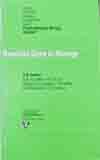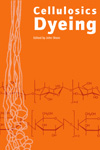Can you suggest a monofunctional dye that would give a darker shade than Reactive Blue 19?
Name: Marlin
—ADVERTISEMENTS—
Victor B. Ivanov's

Reactive Dyes in Biology and Medicine
Explains use of reactive dyes for staining proteins or carbohydrates
Waring and Hallas's

The Chemistry and Application of Dyes (Topics in Applied Chemistry)
includes recipes for synthesizing reactive dyes
Heinrich Zollinger
Color Chemistry: Synthesis, Properties, and Applications of Organic Dyes and Pigments
John Shore's

Cellulosies Dyeing
Useful information about the chemistry of reactive dyes, and other dye types
Message: Thank you for getting back to me. [link] You seem to know more about reactive dyes than anyone I've come across. I have used Reactive Blue 19 (monofunctional vinyl sulfone) with success to dye protein molecules in solution. As the protein concentrations are not high, I was hoping to find a darker dye to mark them. My natural thought was to try a black dye, presumably the darkest color available. Bifunctional dyes cause cross-linking between protein molecules in solution, rendering them insoluble. Can you suggest a monofunctional dye that would give a darker shade than Reactive Blue 19?
That's an interesting question. Perhaps surprisingly, black dyes are not always much darker in color than dyes of other hues. It is necessary to use a much larger quantity of black dye powder, when dyeing textiles, as you would use for any other color, because otherwise black dyes tend to produce undesirably light hues, shades of gray rather than black, usually tending toward a non-neutral color such as blue, purple, or green.
What you want is not a dye that is darker in color, but one which has a higher tinctorial strength. I think the best results I've had along these lines, in dyeing fabric, have been with navy blue dyes. Among the dichlorotriazine dyes, I've obtained somewhat darker results, with less dye, using Reactive Blue 9, which I purchased from Standard Dye, or reactive Blue 109, which is sold as Procion Cobalt Blue by Dharma Trading Company, and as Pro Mixing Blue by PRO Chemical & Dye. (If you order from Standard Dye, make it clear to them that you want only the Colour Index number you agree to, not a mixture which produces approximately the same hue.)
The monofunctional Cibacron F dyes (now renamed to Novacron by their new manufacturer, Huntsman Textile Effects) have been claimed to have higher tinctorial strength than the older Procion dyes, based on the selection of the chromophores. If you look at Sacracron F dyes at PRO Chemical & Dye, which are the Cibacron/Novacron F type, the color Deep Navy (Reactive Blue 184) is obviously much more intense, when used to dye a sample at a 4.0% depth of shade, than the color National Blue (Reactive Blue 182) at the same strength. The Rich Black in the same line of colors required two and a half times as much dye powder to get the intense black shown in its color chip on the same page. Reactive Blue 184 might be a good choice for you to test first. ProChem is a handy place to order the dye from, since they will sell you a jar as small as two ounces.
Inconveniently for your purposes, newer bifunctional dyes are always claimed to have greater tinctorial strength than monofunctional dyes, perhaps because of reduced loss of reactivity due to degradation of the reactive section of the dye molecules after manufacture.
Many dyers have observed that the best acid dyes produce more intense colors on protein fibers than the best reactive dyes. I wonder if that would be another answer for you. Acid dyes are used to dye protein fibers, never cellulose fibers, unlike reactive dyes, which are used to dye both. The bonds that are formed between acid dye and fiber are weaker than the covalent bonds formed between reactive dye and fiber, which might be a problem for you. (See "What kinds of chemical bonds attach dyes to fibers?".)
I don't know whether acid dyes are typically used in quite the same way as you are using your reactive dyes, but of course there are many acid dyes frequently used as protein stains. For example, Coomassie Brilliant Blue, which is also known as Colour Index Acid Blue 90, is commonly used for quantifying protein. I used it that way myself as an undergraduate. It's one of the acid dyes commonly used by hand dyers, sold by PRO Chemical & Dye under their name Wash Fast Acid Brilliant Blue 490.
The explanation for why acid dyes should produce more intense hues than reactive dyes goes as follows. When a reactive dye bonds to cellulose, it can attach to any one of the many glucose molecules in the cellulose chain, because it reacts with an OH group. The large number of dye sites make for a high maximum intensity of color. In contrast, when a reactive dye bonds to protein, forming the covalent bond of a reactive dye at a high pH, the only amino acids available for the reaction are those which contain an OH in their side chain, such as serine, in addition to the amine group or carboxylic acid group at the end of the final amino acids, at either end of the protein molecule. Since only a minority of the amino acids in, for example, a silk molecule, can provide an OH group, a reactive dye may produce a somewhat weaker color on protein than on cellulose. (See the Dye Forum discussion, "Silk Dyeing Question.) In contrast, an acid dye forms hydrogen bonds, instead of the covalent bond of a reactive dye, and can attach along the chain of the protein molecule wherever hydrogen bonding is possible.
To complicate matters considerably, the reactive dyes we use on cellulose, when applied to protein fibers at a low pH, do not form covalent bonds as reactive dyes, but instead form hydrogen bonds and salt linkages like an acid dye. A reactive dye can easily be forced to act as an acid dye on protein fibers, if the conditions are appropriate, since the chromophore regions of reactive dyes, without the reactive region, has the same sort of structure as any acid dye. When it bonds as an acid dye, a reactive dye is less firmly attached to the protein molecule than when it bonds as a reactive dye. At what pH do you attach your Reactive Blue 19 to your protein? Can you tell me what your general procedure is for using Reactive Blue 19 as a stain for proteins in solution?
Many dyers feel that the best of the dyes commonly used for hand-dyeing protein fibers are the ones in the Lanaset series. They are known for producing more intense colors, with a smaller amount of dye, than any of the other dyes that are readily available to hand dyers. They are more expensive than many other dyes for protein fibers, but their high tinctoral strength, and other properties including much higher washfastness than other acid dyes, make them worth the cost. I wonder if this would make them more suitable for your purpose. Take a look at my page, "Which Lanaset dye colors are pure, rather than mixtures?. Lanaset dyes are said to contain both acid dyes and reactive dyes, but I believe that the reactive dyes that may be sold along with Lanaset dyes are all actually Lanasol dyes. Both types of dye in the Lanaset series are considerably more wash-resistant than other dyes used for protein-containing textile fibers. While most acid dyes are tested for washfastness on protein-based fibers by washing the dyed material in lukewarm water, at 40°C, Lanaset dyes resist being washed off of fibers when washed in hot water, at 60°C. Unlike other reactive dyes, the Lanaset dyes are applied at a mildly acid pH.
A common observation for dyeing with reactive dyes, such as vinyl sulfone or Procion dyes, is that the dyebath remains dark in color after the dyes are fixed on the fiber; extensive washing is required to separate unattached dye molecules from the dyed substrate. In contrast, acid dyes typically "exhaust" onto the fiber, forming a close association with the molecules of the even before they have fully bonded to it, leaving a colorless dyebath behind. I would imagine that this different behavior would be interesting when staining proteins in solution.
Lanasol dyes, formerly made by Ciba Geigy, now (like the Cibacron/Sabracron/Novacron dyes) made by Huntsman Textile Effects, are reactive dyes for wool that are based on a alpha-bromoacrylamido group, which reacts with the protein in wool by a nucleophilic addition reaction. Unfortunately for your purposes, I've just read in Robert M Christie's book, Colour Chemistry, that there is a possibility that the Lanasol dyes might be considered as bifunctional, if the second bromine atom in the dye's reactive group also reacts with the protein, via nucleophilic substitution, which would in principle, he says, lead to cross-linking of the fiber.
My conclusion is that you should consider testing Reactive Blue 184 from PRO Chemical & Dye as your next reactive dye, and consider whether one of the Lanaset acid dyes might work for you.
(Please help support this web site. Thank you.)
(Please help support this web site. Thank you.)
Posted: Friday - June 03, 2011 at 06:50 AM
Follow this blog on twitter here.
Quick Links
- All About Dyes & Dyeing Top -
- Top of this blog -
- FAQ -
- The Dye Forum -
- How to Tie Dye - How to Batik -
- Books - Toys - Plants -
- Top of this blog -
- FAQ -
- The Dye Forum -
- How to Tie Dye - How to Batik -
- Books - Toys - Plants -
More in this category:
- -
Statistics
Total entries in this blog:
Total entries in this category:
Published On: Aug 29, 2012 02:49 PM
Total entries in this category:
Published On: Aug 29, 2012 02:49 PM
